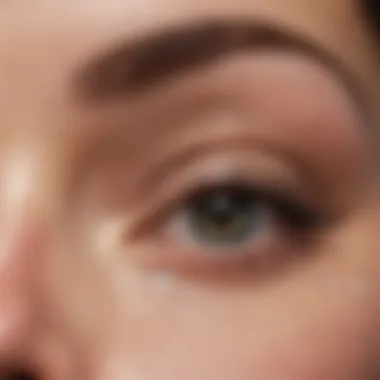Effective Methods to Alleviate Eye Redness and Irritation


Intro
Redness in the eyes can be a frustrating, unsightly concern for many individuals. Whether caused by environmental factors, allergies, or underlying conditions, understanding how to manage and alleviate this redness is paramount to maintaining optimal eye health. In this article, we will delve into various strategies, including home remedies, over-the-counter solutions, and professional interventions. By raising awareness about the differences between temporary eye redness and chronic conditions, individuals can select the most suitable approaches for their specific needs. The conversation will encompass beauty tips, product options, and professional advice, ensuring that readers are well equipped to tackle redness.
Beauty Tips and Tricks
Ocular redness is often exacerbated by irritants in skincare and makeup products. Therefore, adopting thoughtful beauty practices can prevent and mitigate this issue. Below are precise tips to incorporate into your routine to help alleviate redness in your eyes.
Skincare Routine Tips
Establishing a gentle skincare routine is essential for those with sensitive eyes.
- Hydration: Use a good moisturizer to maintain skin barrier function. Look for ingredients like hyaluronic acid or glycerin.
- Gentle Cleansers: Opt for sulfate-free and fragrance-free cleansers to avoid additional irritation.
- Eye Creams: Apply eye creams containing soothing ingredients, such as cucumber extract or aloe vera, to further assist in redness reduction.
Haircare Hacks
Believe it or not, haircare products can affect ocular comfort. Ensure to:
- Avoid Heavy Fragrances: Choose lightweight, fragrance-free options.
- Be Careful with Hair Sprays: Avoid aerosols near your facial area. By targeting products that lessen allergy risks, you invest in fuller comfort.
Makeup Application Techniques
Methodical application of makeup can greatly improve aesthetics while minimizing the perception of glare. Consider these techniques:
- Color Correcting: Use a green tinted primer or concealer to neutralize redness effectively before applying foundation.
- Use Appropriate Materials: Select high-quality, hypoallergenic makeup that won't irritate the eye area.
- Don’t Overapply: A light touch prevents excess product build-up, reducing irritation which leads to redness.
Professional Input
Coping with these ocular issues might sometimes need expert knowledge. Employ insight from professionals for pertinent care. Here’s what you can consult about with your eye doctor or beautician:
Prelude to Ocular Redness
Ocular redness, often reflected in the appearance of our eyes, can be more than mere aesthetic concern. It can signify underlying issues that require attention. Understanding this phenomenon is crucial for beauty enthusiasts, makeup lovers, and skincare aficionados who are keen on complete and holistic well-being.
Eye redness occurs when blood vessels on the surface of the eye become dilated or inflamed, leading to a crimson appearance. This section discusses the significance of recognizing ocular redness not just as a cosmetic issue, but also as a signal of your overall health.
Ocular redness can stem from a range of factors. Identifying the root cause enables better management and corrective actions. For example, temporary redness often arises from environmental irritants or fatigue. Each cause may require a differing response, making awareness key.
The benefits of understanding and managing eye redness are multifaceted.
- Preventive Awareness: Knowing the common causes helps anticipate and possibly prevent the occurrence of redness.
- Effective Treatment Strategies: When equipped with knowledge, you can select appropriate remedies promptly, thus reducing discomfort.
- Social Impressions: Since the eyes are a focal point in communication, addressing redness can enhance initial perceptions and overall confidence.
Moreover, considerations around persistent redness can keep you proactive about ocular health, thus avoiding complications that may arise from disregarding symptoms.
In essence, delving into ocular redness is not merely an investigation of its visual implications; it encompasses a broader discourse on health awareness and informed self-care practices. Understanding its nuances lays the groundwork for further exploration in this article on methods designed to alleviate redness in the eyes.
Common Causes of Eye Redness
Understanding the common causes of eye redness is crucial for managing this prevalent condition effectively. By identifying underlying issues, individuals can determine the appropriate methods for alleviation, whether through home remedies, over-the-counter solutions, or professional treatments. Eye redness can result from various factors, some innocuous and others needing attention. Being informed about these causes allows for better decision-making regarding eye care, enabling individuals to maintain optimal eye health.
Environmental Factors
Environmental factors play a significant role in ocular redness. Common culprits like pollution, smoke, or dust contribute to irritation and inflammation in the eyes. While spending time outdoors, one may inadvertently expose their eyes to harmful elements. Dry air can exacerbate feelings of discomfort, while prolonged exposure to screens can also cause redness due to strained focus and dryness. To protect your eyes, consider implementing measures to improve air quality at home, such as using air purifiers or ensuring proper humidity levels.
Allergies
Allergies are a leading cause of red eyes among many individuals. Pollen, pet dander, and dust mites are some allergens that can trigger reactions. When an allergen contacts the eye, it can cause sampling tenderness and swelling.
- Symptoms common to allergic reactions may include redness, itchiness, and watery discharge.
- Identifying specific triggers can make managing these symptoms easier; individuals should seek allergy testing if persistent and problematic. Using antihistamine eye drops can provide temporary relief and help reduce redness in affected eyes.
Infections
Infections may also provoke redness the eyes. Conditions such as conjunctivitis (pink eye) are common examples that require prompt attention. Whether viral or bacterial, these infections can significantly affect one’s quality of life. Often, simultaneous symptoms accompany redness, including:


- Discharge from the eye
- Increased tearing
- Puffiness around the eyes
It is crucial to seek advice from an eye specialist if drainage or discomfort arises. Proper diagnosis and treatment enable swift recovery while deeply minimizing risks of spreading quite so.
Fatigue and Stress
Fatigue and stress are significant factors that contribute to ocular redness. Impacting both physical and mental health, fatigue can precipitate symptoms of eye discomfort such as fatigue, circumstances like daily stress. Lack of sleep can also manifest in the form of redness due to excessive strain on the blood vessels.Daily habits like late-night screen time can worsen the issue.
To mitigate these stresses:
- Establish a regular sleep schedule to ensure sufficient rest.
- Include relaxation techniques to calm both mind and body.
While minor adjustments to one's lifestyle can mean the difference between relief and discomfort, being aware of these predominant causes can guide successful management of confused,wx disturbed,,eyes.
Identifying the Type of Redness
Identifying the type of ocular redness is crucial for determining the right treatment approach. Each type of redness has its own causes and requires different solutions. Understanding whether your eye redness is temporary or chronic is fundamental. A proper identification can make a significant impact on eye health.
Temporary Redness
Temporary redness often occurs due to short-term conditions. This can include irritants like smoke, wind, or excessive screen time. Allergens such as pollen or pet dander also trigger temporary redness. Stress and lack of sleep contribute too. Symptoms of temporary redness generally fade when the underlying cause is removed.
Here are some common examples:
- Allergy exposure: Around pollen or dust can lead to temporary redness.
- Environmental irritants: Strong winds or smoke create redness as the eyes react to these stimuli.
- Fatigue or poor lighting: Extended screen time or inadequate lighting conditions can tire the eyes.
Advantages of Identifying Temporary Redness
- Simplicity of Treatment: It usually subsides quickly once an irritant is removed.
- Less Concern: Temporary redness often doesn’t indicate any serious conditions.
- Cost-Effective: Home remedies can be effective and often require minimal to no expense.
Chronic Redness
Chronic redness, on the other hand, is more concerning and often indicates ongoing issues. This includes conditions such as dry eyes, uveitis, or conjunctivitis. Chronic redness may not be easily resolved. Therefore, understanding its nature is important for effective management.
Symptoms of chronic redness include any sustained symptoms further than a few hours or accompanying discomfort, like itching or burning.
Some underlying causes may include:
- Persistent allergies: Continued exposure can lead to long-term redness.
- Ocular conditions: Diseases such as blepharitis or ocular rosacea require specific treatments.
- Seasonal issues: For some, chronic redness is part of a long-term allergic reaction or dry eye syndrome.
Benefits of Addressing Chronic Redness
- Targeted Management: Knowing what causes chronic redness can lead to doctor consultation.
- Preventing Complications: Treating underlying issues avoids further complications related to chronic conditions.
- Quality of Life Improvement: Strategizing treatment options can make a noticeable difference in daily comfort and vision.
“Identifying the type of ocular redness is crucial for appropriate management. Ignoring the signs may lead to persistent issues.”
Home Remedies for Red Eyes
Home remedies for red eyes are crucial in managing eye discomfort for many individuals. These methods often serve as a first line of defense against mild irritations without the side effects commonly associated with pharmaceutical solutions. Incorporating home remedies can provide significant relief, making everyday routines much more comfortable. Importantly, these remedies promote awareness regarding the balance of one’s eye health and everyday environmental factors.
Cold Compresses
Cold compresses can significantly alleviate redness and swelling in the eyes. This technique involves placing a clean cloth soaked in cold water or ice packs wrapped in a cloth over the eyelids. The coolness constricts blood vessels, thereby reducing inflammation. For many, applying a cold compress can provide immediate relief after a long day of staring at screens or enduring allergy triggers. It is essential to limit application to around 10-15 minutes, with intervals, to avoid skin damage or discomfort. Several sources concur that regular usage can lead to noticeable improvement in overall eye clarity and comfort.
Artificial Tears
Artificial tears offer hydration and comfort to irritated eyes. Unlike regular moisturizing drops, this option provides additional lubrication to alleviate dryness while also washing away potential allergens or irritants. It is important to choose the appropriate type based on personal needs—preservative-free options often appeal to those with sensitive eyes. Frequent usage can help maintain moisture and reduce daily discomfort caused by allergens or environmental fluctuations. Those navigating eye dryness should remember to check ingredients, ensuring that it supports their unique eye environment and maintaining optimal lubrication.
Hydration Techniques
Staying hydrated contributes directly to maintaining eye moisture. The recommended intake varies by individual activity levels and environmental conditions but aiming for at least eight 8-ounce glasses of water daily is often suggested. Proper hydration helps in maintaining the tear film and can soften symptoms of dryness or redness. Moreover, incorporating food rich in Omega-3 fatty acids, such as salmon or walnuts, can further enhance hydration levels. With effective hydration techniques, individuals under ailments such as eye strain or allergies often notice a marked improvement in their ocular health. Keeping a water bottle close by can be an easy reminder to remain hydrated throughout the day.
Proper Sleep and Relaxation
Having a regular sleep schedule is paramount. Sleep deficits have profound effects on one’s overall health, worsening symptoms of redness and irritation in the eyes. Aim for seven to nine hours per night to ensure that the body, eyes, and mind recuperate fully. Creating a relaxing environment before bedtime, including minimizing screen exposure in the hour prior, contributes positively to sleep quality. Moreover, integrating relaxation techniques during the day, such as deep breathing or short exercise routines, can ease overall stress levels that indirectly impact eye comfort. Addressing lifestyle factors can yield better outcomes for maintaining untroubled and clear vision.


Remember, the eyes reflect your overall health; taking proactive measures can save untold discomfort.
Understanding the significance of these home remedies fosters effective actions toward achieving and maintaining eye wellness. By addressing discomforts with straightforward techniques, individuals enhance their everyday experience regarding eye health.
Over-the-Counter Solutions
Over-the-counter solutions play a crucial role in managing ocular redness, providing accessible treatments for those seeking immediate relief. These solutions can address a range of causes and symptoms without the need for direct prescriptions from eye specialists. Understanding the specific products available is invaluable for beauty enthusiasts, makeup lovers, and skincare aficionados looking to maintain healthy eyes.
Antihistamine Eye Drops
Antihistamine eye drops are formulated to combat allergic reactions that cause red eyes. Allergies trigger histamine release, leading to inflammation and redness. Using antihistamine drops such as KetaTears can effectively reduce these symptoms.
- Quick relief: These drops alleviate redness quickly, making them suitable for immediate use during allergy season.
- Safe for regular use: Most can be used regularly, providing continuous support for individuals with chronic allergic responses.
However, potential users should also be aware of possible side effects. Some individuals may experience temporary stinging. It is wise to read usage guidelines carefully.
Eye Whitening Drops
Eye whitening drops are designed to reduce redness and make the eyes appear brighter and more alert. Brands like Visine Eye Drops can effectively constrict blood vessels in the eye, achieving a whiter look.
- Aesthetic Benefits: These drops serve not only to relieve discomfort but also to enhance one’s appearance, making them particularly popular among makeup lovers who wish to achieve a more polished look.
- Temporary Solution: They provide a quick fix, but effects are often temporary. Frequent use may lead to rebound redness if over-utilized.
Users should exercise caution. It's essential to follow guidelines to prevent dependency on these products and potential irritation or dryness from overuse.
Consulting Product Labels
Product labels are essential tools in selecting the right over-the-counter solution. Understanding ingredientes is key to effective treatment and avoiding adverse reactions.
- Active Ingredients: Pay close attention to the active components listed. Products containing tetrahydrozoline are typically vasocontrictors that create whiteness. Those with ketotifen can treat allergic forms of redness in direct eye contact.
- Usage Instructions: Follow the recommended dosage and frequency to maximize benefits and minimize side effects.
- Expiry Dates: Always check expiration dates to ensure effectiveness. Using expired products can aggravate discomfort rather than alleviate it.
Understanding these choices promotes better informed decisions when alleviating eye redness.
In summary, over-the-counter solutions offer valuable options for managing ocular redness. Products like antihistamine eye drops and eye whitening drops provide quick and convenient relief, while consulting product labels ensures safe and effective usage. By equipping yourself with the right knowledge about these solutions, you empower your approach to eye health, fitting seamlessly into routines oriented towards beauty and self-care.
Lifestyle Choices to Reduce Redness
Making informed lifestyle choices plays a critical role in alleviating ocular redness. This section dedicates itself to outlining effective strategies for managing eye health through daily habits and choices. Factors like screen usage, indoor environment, and nutrition converge as key elements impacting eye comfort and visual well-being. Understanding and implementing these factors can provide profound benefits in maintaining optimal eye health and minimizing redness.
Screen Time Management
In the modern digital age, excessive screen time has become a norm for many. Prolonged exposure to computer, tablet, or smartphone screens can lead to digital eye strain, a major contributor to red eyes. It is clear that managing screen time is essential for reducing discomfort.
- The 20-20-20 Rule: To combat eye strain, take a break every 20 minutes by looking at something 20 feet away for 20 seconds. This simple practice helps relax eye muscles.
- Optimize Screen Settings: Adjust the brightness and contrast to fit the illumination in your surroundings, while reducing glare by using anti-reflective glasses.
- Blue Light Filters: Consider using glassses or software options that filter out blue light, which can disturb sleep patterns and lower overall eye comfort.
Embracing these strategies aid in lowering the probability of sustained redness caused by excessive screen exposure, enhancing not just visual comfort but also productivity.
Air Quality Improvement
Air quality significantly influences eye health. Poor air conditions such as dust particles, smoke, and pollutants contribute heavily to ocular discomfort, thus making air quality improvement vital.
- Indoor Plants: Adding indoor plants such as snake plants or peace lilies can help purify air and enhance moisture levels.
- Air Purifiers: Using HEPA filters will help remove allergens and pollutants from the air, promoting a healthier indoor environment.
- Regular Cleaning: Maintaining cleanliness by dusting and vacuuming can help minimize irritants.
The immediate surroundings play an essential role in eye moisture and comfort. Improving air quality can foster an environment conducive to eye health and irritation relief.
Nutritional Considerations
What is consumed plays a crucial role in maintaining good eye health. Specific nutrients can contribute significantly to preventing ocular redness and promoting eye hydration.
- Omega-3 Fatty Acids: Foods rich in omega-3s, such as salmon and flaxseeds, can enhance tear production and reduce dryness.
- Vitamins A, C & E: Including fruits and vegetables high in these vitamins, like carrots and citrus fruits, helps improve overall eye health and combats inflammation.
- Hydration: Consuming plenty of fluids, primarily water, prevents dryness that leads to concentration of redness.
Mindful eating practices contribute to long-term eye health. Nutritional choices not only improve general health; they also specifically target the needs of the eye, lessening occurrences of redness.
A combination of proper screen management, improved airflow, and nutritional awareness can neatly reduce redness in the eyes, positively impacting overall eye health.
Professional Treatments for Persistent Redness


Dealing with persistent eye redness requires attention and often professional help. While home remedies and over-the-counter solutions can address temporary issues, they might not be effective for ongoing redness. Different conditions cause this prolonged irritation, necessitating a more serious approach. This section explores key aspects of professional treatments, their role in recovery, and the level of expertise involved.
Consultation with Eye Specialists
Seeing an eye specialist is an important first step for anyone suffering from ongoing redness. These professionals, including optometrists and ophthalmologists, possess the knowledge and tools to diagnose underlying issues accurately. Conditions like conjunctivitis, glaucoma, or more severe ocular diseases may present with symptoms of redness and require tailored treatment solutions.
When you consult with an eye specialist, be prepared with your medical history.
- List any medications you take
- Detail your symptoms, such as frequency and duration of redness
- Report any accompanying symptoms, such as pain, itchiness, or discharge
An eye exam may involve various tests to evaluate visual acuity, pupil response, and the overall condition of the eyes. This helps in pinpointing the exact cause of the redness. Getting professional insight ensures you address the problem effectively and safely.
“When it comes to eye health, being proactive can lead to better outcomes.”
Medicated Eye Drops and Treatments
Medicated eye drops often provide immediate relief for various conditions that cause persistent redness. Depending on the diagnosis made by your eye specialist, different types of medicated drops may be prescribed. These examples include antihistamine drops for allergies or prescription steroid drops for inflammatory issues.
It's vital to understand that misuse or overuse of these medicated drops can lead to further irritation or dependency. To avoid complications, always follow your eyecare professional’s instructions. Possible benefits of using medicated treatments include:
- *Reduction in redness and irritation
- Improved vision clarity
- Long-term management of chronic conditions*
Discussing the potential side effects with your practitioner will also help in making informed choices.
Surgical Options
In more severe cases where redness does not improve with other treatments, surgical options may become necessary. Surgical interventions are generally rare and often considered a last resort. Some options may include:
- Pterygium surgery: Removes a growth from the eyeball if it affects vision.
- Trabeculectomy: Relieves pressure in the eye for those with glaucoma, mitigating redness.
- Eyelid surgery: Corrects issues with tear drainage that may contribute to irritation.
These procedures require consultation with highly trained specialists who can assess the risks and benefits.
Surgical treatments can lead to a significant improvement not only to eye appearance but functionality as well. Nevertheless, each case is unique.
By seeking professional help, you consummate an informed approach towards eye health, especially when contending with persistent redness and discomfort.
Epilogue
In understanding how to manage ocular redness, it is crucial to grasp that the approaches range from simple home remedies to in-depth professional treatments. This article aims to provide an extensive overview of multiple methods specifically tailored to alleviate redness in the eyes.
Benefits of Understanding the root causes of eye redness cannot be overstated. By recognizing the specific triggers, individuals can employ more effective strategies for relief. Different factors such as allergies, environmental irritants, and fatigue play a significant role in prompting these symptoms, and identifying them allows for more customized solutions.
Moreover, utilizing effective home remedies—like cold compresses and artificial tears—allows individuals to take charge of their eye health in a simplistic manner. These inexpensive methods can easily be introduced into a daily routine. Over-the-counter solutions, such as antihistamine eye drops, play a vital role in offering quick relief while one seeks additional help when needed.
When redness persists, professional treatments offer more targeted solutions. Consulting with an eye specialist often helps to rule out any underlying conditions. Medicated eye drops, when appropriately prescribed, can significantly reduce inflammation and discomfort.
Frequent evaluation of one's lifestyle choices can further help in mitigating eye redness. By making small adjustments, such as managing screen time and improving nutritional intake, people can positively influence their eye health.
In essence, a well-rounded understanding of the methods to alleviate ocular redness enables individuals to approach this issue holistically. The combination of preventive measures and targeted treatments not only provides immediate relief but also promotes sustainable eye health in the long term.
Ultimately, prioritizing one’s eye care reflects a commitment to personal well-being, making educated choices about how to mitigate redness in the eyes an integral part of health maintenance.
Frequently Asked Questions
This section addresses some of the common queries regarding ocular redness. Understanding these questions is invaluable for readers seeking clarity on managing their eye health. Often, people find themselves grappling with uncertainty concerning redness in their eyes. This confusion can hinder effective self-care and lead to inappropriate solutions.
When to Seek Professional Help
Determining when to consult with a medical expert about eye redness can be daunting. It is essential to be observant of accompanying symptoms that may signal a need for professional evaluation. Consult a doctor if:
- Persistent redness lasts more than a few days. This can indicate an underlying condition needing attention.
- Accompanied by pain, this could signify issues like infections or inflammation.
- There is a change in vision, even mildly blurry sight can be a cause for concern.
- You experience discharge from the eyes, often linked with conditions such as conjunctivitis. This could range in color and indicate different afflictions.
- Signs of swelling or more severe symptoms, suggesting a potentially serious situation.
When in doubt, erring on the side of caution is wise. Early intervention can prevent complications. Understanding your body’s cues allows for more personalized care.
How to Prevent Eye Redness
Prevention is often more effective than treatment. Mindful choices can greatly influence eye health, minimizing the chances of redness developing. Here are key strategies to consider:
- Maintain hydration: Drink enough fluids regularly to keep the body, including the eyes, adequately hydrated.
- Manage screen time: Limiting screen usage and taking sizable breaks reduces strain, which can lead to eye redness.
- Regularly clean eyelids: Using gentle cleansing wipes or warm water can remove allergens or irritants that build up on the surface.
- Use air purifiers: Improving indoor air quality can help be vital, reducing irritants in the air that may cause allergic reactions.
- Wear sunglasses: Protection from sun exposure and wind can lessen irritation and dryness.
- Consider allergens: Being aware of factors like pollen or dust is beneficial. Try to minimize exposure during high season.
By implementing these strategies, individuals can measure link between personal habits and eye health. Establishing healthy practices not only alleviates redness but enhances overall well-being.







